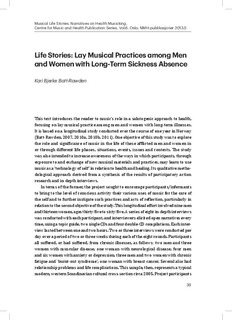| dc.description.abstract | This text introduces the reader to music’s role in a salutogenic approach to health, focusing on lay musical practice among men and women with long-term illnesses. It is based on a longitudinal study conducted over the course of one year in Norway (Batt-Rawden, 2007, 2010a, 2010b, 2011). One objective of this study was to explore the role and significance of music in the life of these afflicted men and women in or through different life phases, situations, events, issues and contexts. The study was also intended to increase awareness of the ways in which participants, through exposure to and exchange of new musical materials and practices, may learn to use music as a ‘technology of self’ in relation to health and healing. Its qualitative methodological approach derived from a synthesis of the results of participatory action research and in-depth interviews.
Through the interviews and their analysis, I learned how the participants used music and how they engaged in self-monitoring practices and self-care. By using the healthpromotion procedure through an action-oriented, participatory musical methodology, it was possible to explore further the connections, links and relationships between musicking, health, wellbeing and quality of life in-depth, and to investigate how and why research participants believed that some types of music or musical materials came to ‘work’ for them, in close relation to their musical biographies. Over the course of the study, it became quite clear that all of the participants had strong connection with music, thanks to a host of biographical and situated couplings that generated music’s power and effect upon them. The findings here suggest thatmusic’s benefit derives from and through musicking—listening, playing and singing but also musical reflection and narrative—and that its healing powers are directly proportional to the connections music provides to other people and times, and to the sensual or meaningful material itself. Agency, empowerment and learning were not caused directly by music, acting as a kind of objective force, but by music’s specific ability to provide mechanisms and affordances for achieving those healing effects. Even when music was shared, enjoyed and appreciated in social circles, it represented a personal choice. | nb_NO |
